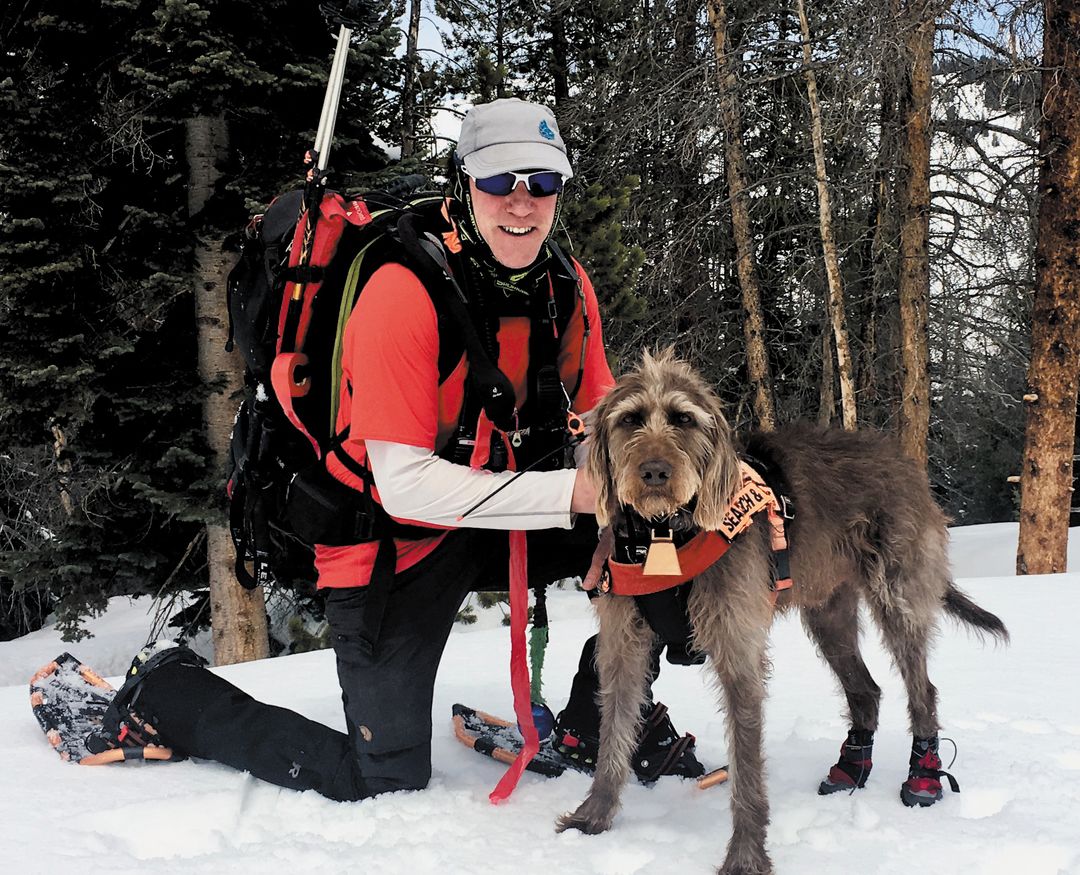Please, Be Careful Out There!

Searching for a missing skier on Vail Mountain with K9 Halo in May, 2019
Like many who move to Vail, for the past six years, I’ve been working two jobs. But unlike those who may need to pull double shifts to pay Airbnb-inflated rent on service industry wages, I’m paid for only one of them: the 40+ hours I log each week as editor of this magazine. My other job? I’m on call 24-7 as a volunteer first responder with Vail Mountain Rescue Group (VMRG), one of the 50-plus nonprofits profiled in our guide to local giving pegged to Colorado Gives Day ("Charity Case," p. 97.)
Since then, things have changed, yet remained the same. Based in a handsome two-story headquarters building on a public safety campus shared with the fire and ambulance service in Edwards, annual operations of Eagle County’s self-funded mountain rescue team are supported by the interest earned from a $2 million endowment created by the Friends of Mountain Rescue, VMRG’s fundraising affiliate. Our “cache” (as we refer to our HQ) is appointed with a climbing wall, an operations center with digital mapping computers and flat-panel television screens, a training classroom, and vehicle bays crammed with a fleet of four-wheel-drive rescue trucks, high-performance snow machines, ATVs and UTVs, whitewater rafts, UAVs/drones, maybe a half-mile of rope, racks of carabiners, rescue litters, GPS units, satellite phones and emergency locator beacons, hundreds of topographic maps, dozens of 800 MHz and VHF radios—millions of dollars of equipment, all of it donated by generous benefactors.
Unlike most nonprofits, VMRG has no paid staff, just 70-something members who refer to ourselves as “volunteer professionals” certified as wilderness first responders, avalanche rescue technicians, high-angle rope rescue technicians, swiftwater rescue technicians, UAV pilots, and canine handlers. Each of us is expected to outfit ourselves for the field, purchasing thousands of dollars’ worth of personal protective equipment—Gore-Tex Pro jacket and pants, down and synthetic insulating layers, alpine touring skis and boots, snowshoes, avalanche beacon/shovel/probe, helmet and harness, and a backpack stocked with enough supplies to survive in the backcountry unsupported for up to 24 hours.
While James Van Beek technically may be our boss—although independently operated and funded, VMRG serves under the jurisdiction of the Eagle County Sheriff’s Office—when a skier goes missing on Vail Mountain, the sheriff doesn’t rouse rescuers from barstools at Vendetta’s (the former Copper Bar); like airline pilots, team regulations prohibit members from fielding within four hours of consuming alcohol. A 911 dispatcher contacts a mission coordinator, who summons members via the county’s public safety text messaging system. As of December 15, 2019, the team had been called out 156 times, assisting 235 individuals who experienced some sort of emergency in the backcountry, from snowmobilers stuck on Muddy Pass to backcountry skiers lost in Lime Creek, never charging for a rescue.
From January through mid-December, I logged 19 missions and 380 volunteer hours (in addition to training and responding with VMRG, I travel weekly to the Front Range and quarterly around the country to maintain certification as a SAR K9 handler). For me personally, the 2018/19 ski season was bookended by a pair of tragedies, both preventable. On November 27, 2018, eleven days after Vail’s lifts started spinning, after helping ski patrollers load the body of a snowboarder into a coroner’s van at the I-70 chain-up station above East Vail, I drove his friends back to Vail Village to give a statement to police (the boarder, a popular Vail Ski & Snowboard Academy instructor, died after hucking a cliff in off-piste terrain). Then on August 17, I met the coroner again, this time with my cadaver dog on Vail Mountain to collect the remains of a Chinese national with an affinity for untracked steeps who disappeared on February 28 while skiing alone in the Back Bowls and appears to have suffered a fate similar to the boarder.
What I’ve come to accept over the years is this: a mountain rescue team can invest millions of dollars in equipment and thousands of hours in training, but once someone decides to tempt the fates by doing something risky outdoors, we still may not be able to save them from themselves.
Ted Katauskas






































